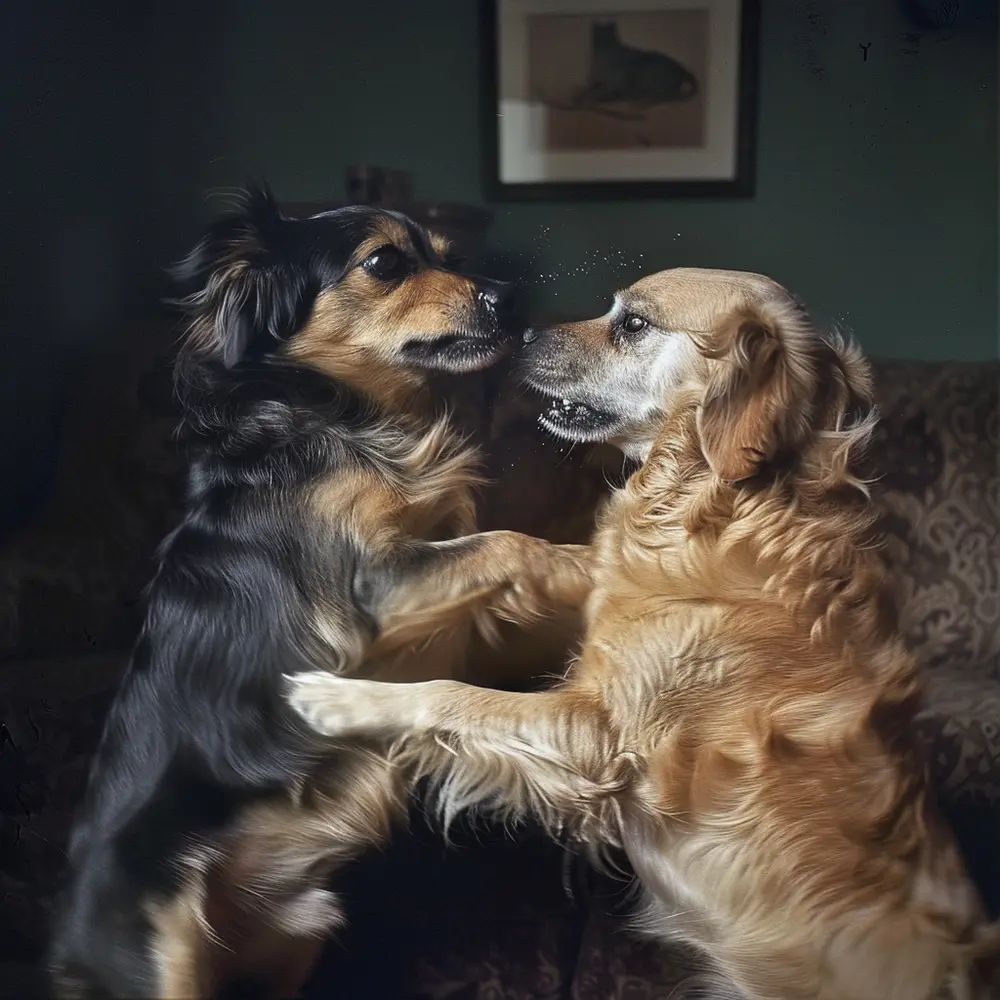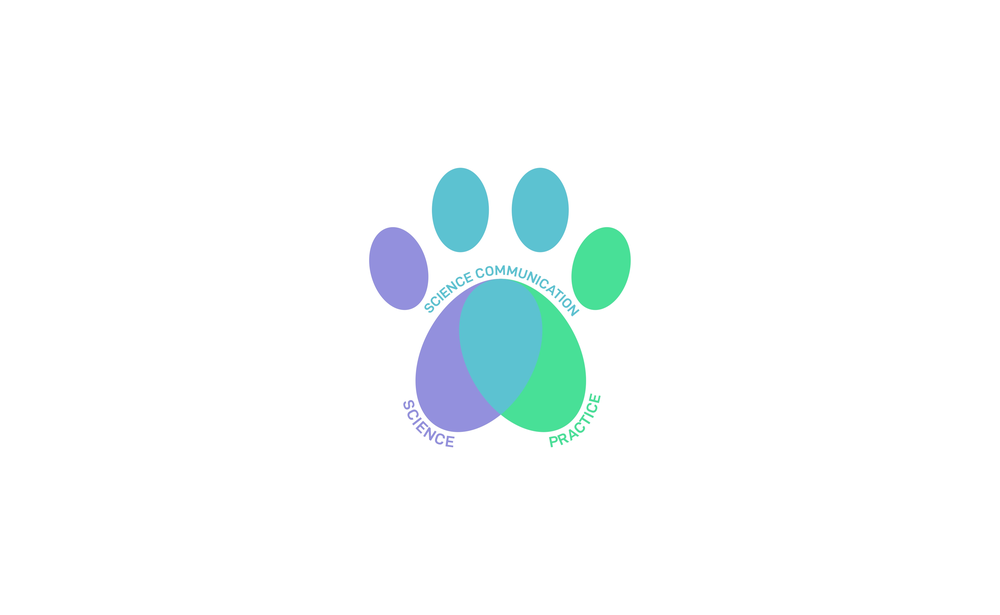Table of Contents:
Understanding Canine Conflict: Recognising the Signs of a Dog Fight
Spotting the early signs of a potential dog fight is crucial for any dog owner and dog professional. When dogs exhibit aggressive behaviours, such as growling, snarling, or fixed stares, they may be signalling an imminent conflict. It's important to understand that these signals do not always lead to a physical altercation, but they are a clear indicator that there is a problem. By intervening at this stage, you can prevent a situation from escalating to a dangerous fight.
A dog that is ready to fight often has stiffened legs, a raised tail, and upright ears. These physical signs are a form of communication between dogs, and being able to interpret them can give you precious seconds to divert a negative interaction. Additionally, you might notice the fur along a dog's back standing on end—known as "piloerection"—which is a physiological response to arousal or agitation.
Recognising these signs in advance can be the best way to break up a dog fight before it starts. However, it isn't always possible to prevent a fight. In that case, knowing the correct intervention techniques becomes critical. Remember, safety should be your top priority; never put yourself in harm's way when trying to stop a dog fight.
The Best Way to Break Up a Dog Fight: Essential Strategies
Finding the best way to break up a dog fight requires careful consideration and swift action. The goal is to separate the dogs without exacerbating the conflict or endangering yourself. Look for the aggressor, which is typically the more assertive dog, and focus your intervention there. Without engaging directly with the dogs, try to distract them using loud noises or by inserting an object between them.
If the dogs are locked onto each other and a safe, non-physical intervention is not possible, you may need to use the wheelbarrow method. Remember, this approach should only be used as a last resort and requires two people. Each person grabs the back legs of one dog, lifting them off the ground, and walks backwards, steering the dogs away from each other. Once separated, ensure that both dogs are securely held or placed in different areas to avoid another confrontation.
It's essential to avoid using your hands or body to break up a fight, as this could result in serious injury. Do not kick or punch the dogs, as this can increase their aggression or cause injury to the dogs. Always call for professional help if the situation is beyond your control or if the dogs do not respond to your attempts to safely break up the fight.
Approaches to Managing Dog Conflicts
| Pro | Considerations |
|---|---|
| Prevents possible injuries to dogs | Interveners might get bitten or injured |
| Reduces stress and trauma for all dogs involved | Unskilled intervention can escalate the conflict |
| Can minimise damage to surroundings | May lead to redirected aggression towards other dogs or humans |
| Maintains control over the situation for safety | Breaking up a fight may require specific knowledge or training |
| Imparts learning and sets boundaries for future interactions between dogs | Improper handling might cause trauma to the dog, leading to long-term behavioural issues |
Wheelbarrow Method: A Two-Person Intervention for Dog Fights
The Wheelbarrow Method is a specific technique designed to be employed when two individuals are available to address a dog fight. This method necessitates an approach from behind the dogs, with each person grabbing a dog's back legs, akin to lifting the handles of a wheelbarrow. This action should be executed with care to maintain stability and control over the situation.
Upon lifting the dogs' rear legs, it's crucial to move in a controlled and deliberate fashion, guiding the dogs away from each other while avoiding any sudden movements that may escalate the tension. The key is to keep moving backwards, preventing the dogs from regaining their footing and thus, continuing the fight. This is not always appropriate, however, and in situations where one dog is locked into another you should push them together before pulling them apart.
Once the dogs are apart, continue to back away in a curve, which makes it difficult for the dogs to turn around and re-engage. This curved retreat helps to minimise the likelihood of the person getting bitten, as it places the individual outside of the dog's immediate range of movement.
After the dogs are fully separated and the immediate danger is mitigated, take care to secure both animals in separate spaces. Monitoring their behaviour and ensuring that there's no further contact between them are crucial follow-up steps.
Solo Interventions: How to Handle a Dog Fight When You're Alone
Being alone during a dog fight can be intimidating, but there are still effective strategies that can be employed to defuse the situation. The priority remains to maintain personal safety whilst attempting to separate the dogs.
In the absence of assistance, finding an accessible object to place between the fighting dogs may redirect their focus. Items such as a large board, a chair, or even a blanket can create a barrier that safely interrupts the conflict. It's important to avoid using items that could harm the dogs or exacerbate the fight.
If access to such objects is not possible, you might consider the 'startle' technique, which involves making an unexpected loud noise to create a distraction. This could give you a momentary window to lead one dog away if they're momentarily disengaged.
Once the dogs have been separated, immediate containment is vital. This may mean guiding one dog into a secure area or using a leash to maintain control. Constant vigilance and quick action are imperative when you're the sole mediator in a dog conflict.
Safety First: When Not to Intervene in a Dog Fight
While the urge to protect our dog is strong, there are times when intervening in a dog fight can be more harmful than helpful. It's important to assess the risk to your own safety before deciding to step in. If the fighting dogs are large, powerful, or particularly aggressive, the potential for serious injury to yourself must be taken into account.
In situations where the fight is at its peak intensity and the dogs are completely focused on each other, any attempt to physically separate them might not only be futile but could also draw their aggression towards you. At such times, it's preferable to wait for the intensity to decrease or to call for professional help.
Moreover, an emotional response, such as panic or fear, could inadvertently escalate the situation. It's crucial to remain calm and avoid shouting, which could add to the tension. If professional support is not immediately available and you're unsure about the right course of action, maintaining a safe distance is the advised choice.
Remember, your well-being is essential in order to provide effective care for your dog, both during and after any conflict. There is no shame in prioritising safety and seeking assistance when the risks of intervention are too high.
Preventing Dog Fights: Proactive Measures for Dog Owners
Ensuring that you never have to break up a dog fight begins with prevention. As a responsible dog owner, it is important to understand and respect the boundaries of dogs. This includes recognising situations or environments that may trigger aggressive behaviour in your pet or others. Avoiding dog parks or areas where aggressive dogs are known to frequent is a proactive step towards preventing fights.
Socialising your dog from a young age can also mitigate aggression. Expose your dog to a variety of environments, people, and other animals to build their confidence and sociability. Training your dog to respond to basic cues like 'sit', 'stay', and 'come' even in the presence of distractions, reinforces your control and can help avert potential conflicts.
Moreover, keep your dog on a leash in public spaces to maintain control and give yourself the option to quickly remove your dog from any tense encounters. Pay close attention to canine body language, not just from your own dog but from others too. Signs of unease or agitation are precursors to a possible fight and should prompt you to steer clear from the source of your dog's discomfort.
Lastly, maintaining routine health checks for your dog ensures they are not suffering from any ailments or conditions that could contribute to irritability or aggression. Illness or pain can significantly alter a dog's behaviour, so keeping your pet healthy is key in preventing fights.
Post-Fight Protocol: Steps to Take After Breaking Up a Dog Fight
After successfully separating dogs from a fight, immediate action is necessary to ensure the well-being of the animals and prevent further incidents. The first step is to calmly move the dogs to a secure and quiet location, away from each other, to reduce stress and prevent a recurrence of the conflict. It is crucial to stay composed and keep your emotions in check, as dogs are sensitive to our demeanour and can react accordingly.
Inspect your dog for injuries, carefully checking for puncture wounds, lacerations, or any signs of pain. Even if the dog appears unharmed, hidden injuries may exist beneath the fur. If you're unsure or if the dog is showing signs of distress, discomfort, or pain, seek veterinary care promptly. It is better to err on the side of caution and get a professional evaluation.
Document the incident for future reference, especially if another person's pet was involved. Write down what happened and how it was resolved. This can be useful for any necessary follow-up with other dog owners or animal control authorities. Additionally, take some time to reflect on what might have led to the confrontation and consider strategies for preventing similar situations in the future. This might involve further training or avoiding specific triggers identified during the incident.
Lastly, provide comfort and reassurance to your dog. A fight can be a traumatic experience for a canine, and they need to feel safe and secure after such an event. Offering gentle petting or quiet time together can reinforce the bond between you and support your dog's emotional recovery.
Seeking Professional Help: When to Call a Vet After a Dog Fight
Knowing when to seek professional veterinary assistance after a dog fight is critical for the health and safety of your pet. If your dog has visible wounds, such as bleeding or torn skin, or you suspect internal injuries from the fight, immediate veterinary attention is necessary. Moreover, shock is a possibility, so watch for symptoms like weakness, collapse, or rapid breathing, and do not hesitate to call your vet or an emergency animal hospital.
Sometimes, the signs of trauma are not immediately visible. Be mindful of changes in your dog's behaviour, such as lethargy, refusal to eat, or unusual quietness, which may indicate pain or distress. Persistent limping or the dog's reluctance to be touched in certain areas are also indicators that a vet check-up is warranted.
It's important not to self-medicate or attempt to treat serious injuries at home. Veterinary professionals have the expertise to properly assess and treat the aftermath of a dog fight. They can also provide you with advice on how to best care for your dog's injuries, prevent infection, and support their recovery.
In addition to physical care, consider a consultation with a professional dog trainer or behaviourist if you notice any lingering behavioural changes after the incident. They can provide strategies to help your dog overcome any anxiety or fear that could result from the altercation, ensuring their overall well-being is managed holistically.
The Role of Dog Body Language in Preventing Fights
Understanding the nuances of dog body language can be integral in identifying signs of distress, discomfort, or aggression, which are often precursors to fights. Dogs communicate both their intentions and emotions through physical cues, and an informed owner can read these signs to circumvent potential conflicts.
For instance, a relaxed dog will have a soft gaze, loose posture, and a gently wagging tail. In contrast, a dog preparing for aggression may exhibit a hard stare, ears pinned back, slowing tail movement, and tense body posture. Recognising these shifts in behaviour allows for timely intervention.
Educating oneself about the various body language signs also includes understanding calming signals, which dogs use to avoid conflicts. These can include behaviours such as licking their nose, turning their head away, or yawning. When noticed, it’s advisable to create space between the dogs involved, allowing them to calm down and potentially avoid a fight.
Continuous observation and interpretation of your dog’s body language during interactions with other dogs is essential. It can guide you on when to step in and remove your dog from an environment that may trigger a fight. By being proactive and responsive to these non-verbal cues, you can safeguard your dog and those around it from aggressive encounters.
Legal and Ethical Considerations in Breaking Up Dog Fights
Dog fights not only raise concerns for animal welfare but also present legal and ethical considerations that owners should be aware of. Legally, dog owners are responsible for their pet's actions, which can include repercussions if their dog instigates a fight. Understanding local laws and regulations pertaining to dog ownership and public safety is crucial in mitigating such risks.
From an ethical standpoint, breaking up a dog fight responsibly means prioritising the safety and well-being of all involved—dogs and humans alike. It is important to refrain from actions that could potentially harm the animals, such as hitting or kicking, as these are inhumane and can lead to legal consequences.
If you witness a fight involving someone else's pets, consider the ramifications of intervening. It may be more prudent to call local animal control professionals who are trained to handle such incidents safely and legally. Any intervention should be made carefully to avoid increasing the liability for yourself and preventing further harm to the animals.
Post-incident, owners may need to report the fight to authorities, especially if there were injuries to either the dogs or people involved. Keeping detailed records of any fights, interventions, and outcomes is recommended for legal protection and as a reference for future preventive measures or training approaches.
Creating a Safe Environment: Reducing the Risk of Dog Fights at Home
Creating a safe and peaceful home environment is a proactive way to reduce the risk of dog fights. This involves managing the living space and resources to prevent competitive or territorial behaviours among resident dogs. Ensure that each dog has their own designated area for eating, sleeping, and taking refuge. This can alleviate tension and prevent disputes over these critical resources.
Introducing routines can also foster a sense of order and security for your dogs, with scheduled times for feeding, walks, and play. Consistency helps dogs understand what to expect and when, reducing anxiety and the chance of unexpected aggressive outbursts.
When adding a new dog to your household, it’s important to do so gradually, with structured introductions in neutral spaces to foster positive associations. Carefully monitor the interactions and intervene if you detect any signs of tension or aggression. Employing the help of a professional dog trainer or behaviourist during this transition can be beneficial.
Always be mindful of your dogs during high-energy situations, such as when they are playing or when guests are visiting. Over-excitement can quickly spiral into aggression, so be prepared to calmly separate your pets and give them time to settle if you notice signs of escalation.
First Aid for Dogs: Caring for Your Dog After a Conflict
Administering first aid to your pet after a conflict is an essential step in ensuring their quick recovery. Initially, approach your dog calmly to avoid additional stress and gently assess them for any injuries. If you find wounds, apply pressure to staunch any bleeding and clean the area with mild soap and warm water to reduce the risk of infection.
Small cuts and scrapes may be treated at home with antiseptic creams and proper bandaging. However, for deeper wounds or if you're unsure of the severity, prompt veterinary attention is recommended. Always wear protective gloves to safeguard your health and prevent any contamination when handling open wounds.
Be observant of your dog's behaviour in the following hours and days, watching for signs of pain, infection, or trauma. Offering a quiet, comfortable space for your dog to recuperate is also important. Be patient and provide gentle care as they recover both physically and emotionally from the ordeal.
Having a well-stocked veterinary first aid kit is advantageous for any dog owner. Include items such as sterile gauze, adhesive tape, antiseptic wipes, and an Elizabethan collar to prevent licking or biting at injuries. Being prepared can make the difference in how effectively you're able to manage post-conflict care for your pet.
Conclusion: Summarising Safe Practices for Dog Fight Intervention
In conclusion, safely intervening in dog fights is a matter of quick thinking, proper technique, and personal safety. Always attempt to prevent conflicts by understanding dog body language and maintaining a controlled environment for your pets. Should a fight occur, employ safe strategies to break it up, such as distraction techniques and, when necessary, the wheelbarrow method with the help of another person.
Post-conflict, assess any injuries and provide first aid, but don't hesitate to seek professional veterinary care when needed. Remember to learn from each incident, working towards better prevention strategies and continued training to enhance the safety and well-being of your canine companions. By following these practices, dog owners can reduce the risk of dog fights and ensure a harmonious environment for all.
FAQ: Safe Intervention in Dog Fights
What is the safest method to break up a dog fight?
The safest method to separate dogs in a fight is the Wheelbarrow Method, which requires two individuals. Each person lifts the hind legs of one dog, walking backwards to steer the dogs apart without engaging directly with them.
Can I intervene in a dog fight when I'm alone?
If alone, use distraction techniques such as loud noises or a barrier between dogs. Avoid physical intervention and remain safe. If the risk is too great, call for professional help.
What should I avoid doing when breaking up a dog fight?
Do not use your hands or body to separate fighting dogs, do not hit or kick the dogs, and avoid physical tools that might cause pain or injury, as these actions can intensify the conflict.
What immediate actions should be taken after a dog fight?
After breaking up the fight, separate the dogs into a secure location, inspect them for injuries, and seek veterinary care if necessary. Stay composed and document the incident for future reference.
How can I prevent dog fights from happening?
Prevention involves understanding canine body language, socializing your dog, training them to respond to commands, and creating a controlled environment to prevent triggers that may lead to aggression.








